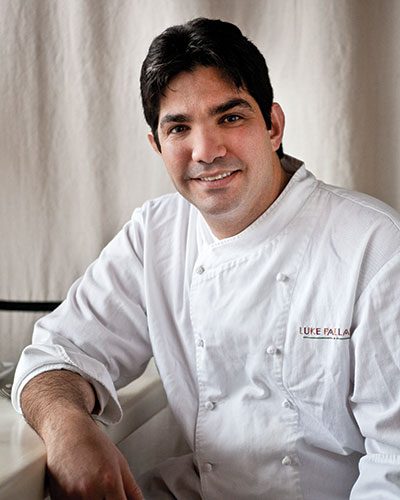




It might seem conceited for a chef to name a restaurant after himself, but Luke Palladino can be forgiven. “I was running seven restaurants at a time,” says the chef, 41, whose roster included Specchio, Ombra and Risi Bisi at the Borgata in Atlantic City. After he closed those more than three years ago, he became a consultant. “I was on airplanes flying all around, I had multiple partners, and I got to a point where the money was tremendous, but I wasn’t happy. My wife said, ‘Why don’t you go back to cooking?’”
Palladino took his wife’s advice last March, when he purchased Kenny’s Kitchen in Northfield from his friend Kenny Guerrier. In six weeks he transformed it into a 30-seat personal atelier with open kitchen. The understated dolphin-gray dining room features framed photos of Venice that Palladino took while cooking at the city’s famed Al Covo. A vintage mirror hangs on one wall, etched with the Italian idiom, tutto fa brodo.
“In Italy,” Palladino explains, “an event will happen in someone’s life, something big or something small, and people will say, ‘tutto fa brodo.’ The literal translation is, ‘everything goes in the broth,’ but it means that every experience enriches us.”
Palladino’s three tours in Italy (Friuli, Emiglia-Romana and Piedmont) over four years in the ’90s have certainly enriched him and his cooking, rigorously regional and seasonal. He changes his menu two or three times a week. Palladino’s pastas are as well made as any I’ve eaten in Italy, whether they be thin chitarra (“guitar”) with crispy soft-shell crabs and roasted grape-tomato marinara; wavy strozzapreti (“priest stranglers”) in coarse Jersey basil-and-walnut pesto; or agnolotti enhanced with Piedmontese ricotta and sottocenere, an ash-rind cheese injected with black truffle. I loved those most—tiny humpback islands in an exquisite sauce Palladino makes by pureeing and straining brandy-flamed shallots, seared foie gras, thyme, bay leaf and cream.
Lamb shoulder chops dressed with balsamic reduction and rosemary were luscious and primally satisfying. In seafood, the show-stopper is whole fish prepared acqua pazza (“crazy water”) style, which merits its $32 price. The specimen changes frequently but is always wild-caught. I had roasted branzino, a Mediteranean sea bass, which the server presented, then brought back to the kitchen for filleting. The fish returned in the acqua pazza, a Napolitano specialty of water and wine electrified with olives, garlic and chilies. “People are amazed how much flavor comes out of it,” says Palladino. I certainly was.
The Liguria region was represented by chunky, lime-green, fava-bean pesto (freshened with lemon zest, marjoram and mint) smeared on thick slices of garlic-rubbed grilled bread. From Sicily came a plate of grilled seafood and petals of caramelized caciocavallo, a provolone-like cow’s-milk cheese traditional to the island. The cheese is flamed with Sambucca and finished with garlic and mint. The zuppa di pesce is a favorite of Palladino’s from Al Covo, authentically recreated down to the scorfano, or scorpion fish, without which you can’t have a proper Italian zuppa di pesce.
Proper, yes, but ultimately disappointing. I enjoyed the meaty, sweet scorfano but was surprised by the puny shrimp, rubbery calamari, clams and mussels, and ordinary garlic-infused white-wine broth. The aforementioned Sicilian mixed grill brought scallops, more tiny shrimp and a fillet of branzino, all bland and sheathed in a thin layer of damp oregano-laced breadcrumbs. Adding to the dismay were the prices, $35 and $30, respectively.
Palladino may have abandoned the glitter of Atlantic City, but his prices are still top drawer. The delectable grissini slathered with truffle butter and twirled with prosciutto are a reprised favorite from Ombra and cost $18 for half a dozen. Sure, the truffle oil is from Umbria, and the prosciutto is the rare rotondo variety and shipped from a Palladino friend’s Parma cellar, but three bucks a bread stick? Regulars call them crack sticks, according to Palladino. They’re addictive, yes, but you’d have to be on crack to pay that much for them.
With those exceptions, everything I tasted—and I tasted nearly three-quarters of the menu—was delicious. Every appetizer (except for a timid Caesar salad) impressed, from the creamy arancini (fried risotto balls) to the intense mushroom-and-Tallegio crespelle to featherweight fried local zucchini chips tossed with grated Locatelli and lemon zest.
The chef’s charm extends to dessert, with creamy ricotta zeppole, petite Valrhona chocolate cake veiled in dark ganache and one of the best panna cottas I’ve ever had—cooked with soft white chocolate, seated in vivid strawberry sauce. Avoid the gelato from Capogiro of Philadelphia—amazing at the artisan company’s own gelaterias, but just icy here—unless it’s a scoop of vanilla gelato served in a cup of steaming-hot espresso for a refresher called an affogato.
As I drained the affogato, Palladino surveyed the dining room from the kitchen. The two spaces are really one, divided only by a burlap curtain that remains open all night, fostering a real sense of communion between chef and diner. As guests departed, Palladino bid them goodbye one by one. That wouldn’t have, couldn’t have, happened at Specchio, Ombra or Risi Bisi.
“Here, I want every table to feel like a chef’s table,” he says, “and I’ve been having fun doing it.”
